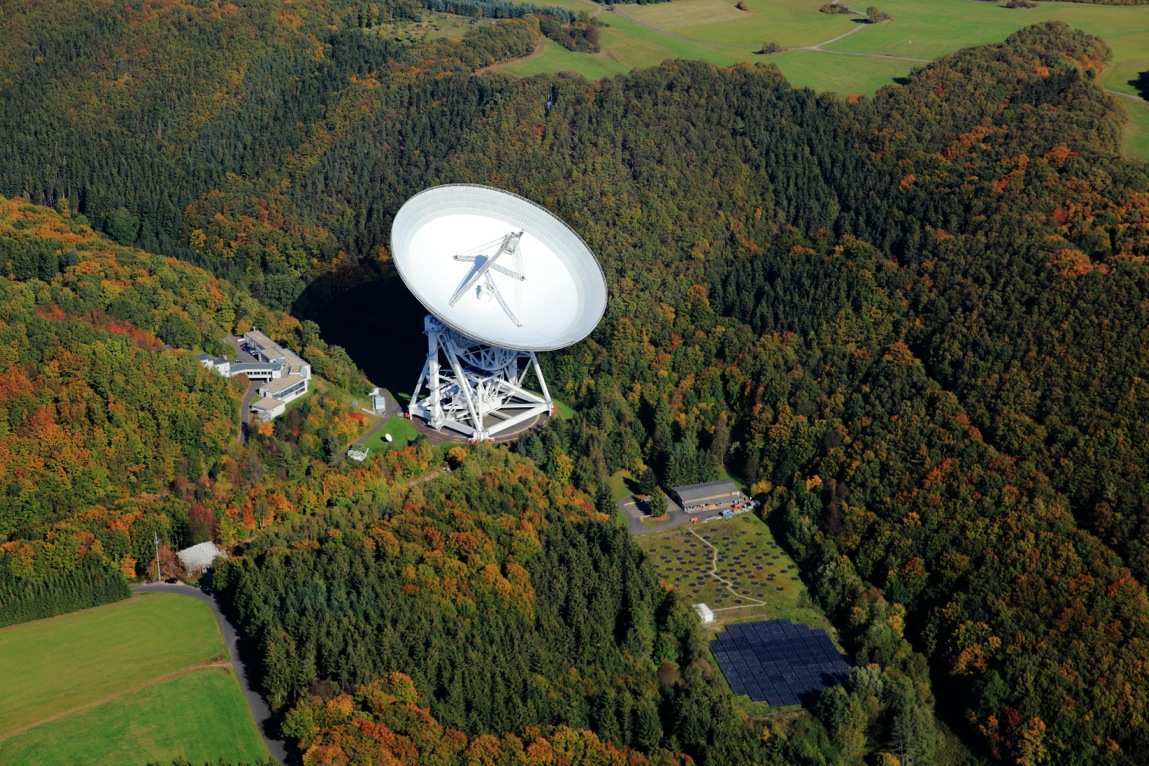Lecture - Motivation and Background
3. Applications of radio interferometry and scientific topics of special interest
Radio interferometers are used to measure the fine angular features of the radio radiation of the sky. The resolution of single radio antennas are restricted to a few tens of arcseconds by physical limitations, which is insufficient for many astronomical purposes. For example, consider the Effelsberg 100 meter radio telescope: the beam-width of the antenna with a diameter of 100 m and a wavelength of 7 mm is about 17 arcseconds. From an engineering standpoint, steerable radio telescopes cannot be built much bigger than that. In contrast, the diffraction limit for large optical telescopes (~8 m in diameter) is about 0.015 arcseconds. However, the angular resolution of optical telescopes achievable from the ground with conventional techniques (i.e. without adaptive optics) is limited to about 0.5 arcseconds due to the turbulence in the troposphere.
 |
|---|
Fig. 1.2 The 100-meter radio dish in Effelsberg, Germany. The control room is located to the left of the dish in the picture. on the bottom right a LOFAR station is also visible. Credit: Peter Sondermann, VisKom/City-Luftbilder
It is important to measure the positions of radio sources with sufficient accuracy in order to connect them with objects detected in the optical and other parts of the electromagnetic spectrum. It is also very important to be able to measure parameters such as the intensity, polarization and frequency spectrum with similar angular resolution in both radio and optical regions. Only by using interferometry techniques in the radio regime is it possible to achieve this. Astrometry is the endeavor of accurately measuring the angular positions of stars and other distant objects. This includes the study of the small changes in the positions of the sky due to parallax caused by the Earth's orbital motion, as well as the changes due to the proper motion of the objects. A precise understanding and mapping of objects in space are important to deduce cosmological parameters.
Astrometric measurements are also a way to test the general theory of relativity and to determine the dynamical parameters of the solar system. For astrometric measurements, it is important to establish a reference frame for the celestial positions. A frame based on extremely distant massive objects as position references would be best. Radio measurements from distant, compact, extragalactic sources currently offer the best conditions for establishing such a framework. The radio technology provides an accuracy of 100 micro-arcseconds or less for absolute positions and 10 micro-arcseconds or less for relative positions of objects that are close together at an angle. Optical measurements of constellations seen through the Earth's atmosphere make it possible to determine positions to an accuracy of about 50 milli-arcseconds. However, using the Hipparcos satellite, the positions of  stars have been measured to an accuracy of 1 milli-arcseconds. The Gaia1 mission is expected to provide the positions of
stars have been measured to an accuracy of 1 milli-arcseconds. The Gaia1 mission is expected to provide the positions of  stars with an accuracy of 10 micro-arcseconds.
stars with an accuracy of 10 micro-arcseconds.
As part of the measurement process, astrometric observations involve determining the orientation of the instrument with respect to the celestial reference frame. Ground-based observations therefore provide a measure of the variation in the Earth's orientation parameters. In addition to the well-known precession and nutation of the rotation axis direction, there are irregular displacements of the Earth's axis with respect to the surface. These shifts, called polar motions, are attributed to the gravitational effects of the Sun and Moon on the Earth's equatorial bulge and dynamic effects in the Earth's mantle, crust, oceans, and atmosphere. The same causes lead to changes in the Earth's angular velocity, which are accounted for with corrections in the universal time system. Measurements of the orientation parameters are important for studying the dynamics of the Earth.
The benefits of using radio interferometry techniques allows for various studies in the following topics:
- Astrometry
- Geodesy
- Studies of Earth's troposphere and ionosphere
- Solar studies
- Solar-Terrestrial relationship
- Cosmology
- Evolution and mechanisms of
- Stars
- Pulsars
- Galaxies (active galactic nuclei, radio galaxies, masers, star forming galaxies, ...)
- Supernova remnants
- Star forming regions
Note: This list is by no means complete and just highlights the number of fields of study that are impacted by radio interferometry techniques.